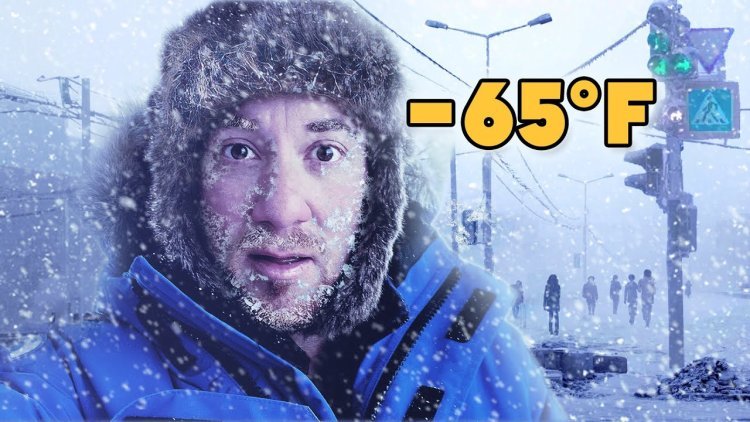Discovering the Top 5 Coldest Places on Earth._ISHEJA

Top 5 Coldest Places on Earth
Dome Fuji, Antarctic
Located in Antarctica, Dome Fuji holds the title for being one of the coldest places on Earth. It has recorded a bone-chilling temperature of -93.2°C in August 2010. This dry, cold desert is known for its extremely low temperatures and is a site of scientific research. The nearby Dome Fuji Station provides valuable insights into the Earth's climate history through ice core drilling.
Vostok Research Station, Antarctica
The Vostok Research Station, also situated in Antarctica, is another contender for the coldest place on Earth. In July 1983, this station experienced an astonishing temperature of -89.2°C, making it one of the frigid locations on our planet. The station has been the site of groundbreaking research, including the exploration of Lake Vostok, a subglacial lake hidden beneath the ice.
Amundsen-Scott South Pole Station, Antarctica
At the South Pole lies the Amundsen-Scott South Pole Station, where some of the coldest temperatures ever recorded have been recorded. In June 1982, the temperature dropped to a bone-chilling -82.8°C. This station experiences six months of complete darkness during the winter, and only one sunrise and one sunset per year. The scientists and researchers stationed here conduct a wide range of studies, from neutrino research to observations of the cosmic microwave background.
Uncovering Extreme Cold Records
Vostok Station, Antarctica
Vostok Station in Antarctica holds the record for the lowest temperature ever recorded on Earth. In July 1983, the temperature plummeted to a jaw-dropping -89.2°C. This Russian research station, established in 1957, experiences extreme cold throughout the year. The station's remote location and harsh conditions make it a challenging place to live and work.
Verkhoyansk and Oymyakon, Russia
In northeastern Russia, the towns of Verkhoyansk and Oymyakon have also earned a place among the coldest locations on Earth. These Siberian towns experience severe cold during the winter months, with temperatures reaching as low as -67.7°C. Verkhoyansk and Oymyakon are known as the Poles of Cold, with long and harsh winters that test the resilience of the local communities.
Snag, Yukon, Canada
While not as cold as some of the other contenders on this list, Snag in Yukon, Canada, still deserves recognition as one of the coldest places on Earth. In February 1947, the temperature dropped to a freezing -62.8°C, setting a record for the coldest temperature ever recorded in North America. Despite its extreme cold, Snag has some unique characteristics, such as sounds carrying much further in the dense cold air.
Intriguing Facts About the Coldest Places
Eastern Antarctic Plateau at -94°C
The Eastern Antarctic Plateau holds the distinction of being the coldest place on Earth. Satellite data has revealed air temperatures as low as -94°C between 2004 and 2016. Due to the extremely dry air in the area, scientists believe that temperatures might reach even colder levels. This region remains largely untouched by human presence and is a subject of scientific exploration and research.
Vostok Station Antarctica at -89.2°C
The Vostok Station in Antarctica, as previously mentioned, recorded a bone-chilling temperature of -89.2°C. Besides being known for its extreme cold, the Vostok Station is home to researchers who live and work there during the summer months. It is considered one of the most isolated and inhospitable places on Earth, requiring specialized training and equipment for survival.
Amundsen-Scott Station, Antarctica at -82.8°C
Situated at the South Pole, the Amundsen-Scott South Pole Station experiences six months of complete darkness and extreme cold. In June 1982, the temperature reached a frigid -82.8°C, making it one of the coldest recorded temperatures on Earth. Despite the harsh conditions, the station's scientific research contributes invaluable insights into various fields of study.
Remarkable Discoveries in Cold Locations
Eastern Antarctic Plateau
The Eastern Antarctic Plateau, with its incredibly low temperatures, provides a unique environment for scientific research. Its dry air and extreme cold make it an ideal location for studying atmospheric conditions, climate change, and glaciology. Researchers are continually uncovering new information about this remote and harsh region.
Vostok Station Antarctica
The Vostok Research Station in Antarctica has been at the forefront of scientific exploration. It is known for its groundbreaking work in drilling ice cores from Lake Vostok, a subglacial lake that has been sealed off from the rest of the world for millions of years. Analysis of these ice cores has provided insights into Earth's past climate and the possibility of microbial life in extreme environments.
Amundsen-Scott Station, Antarctica
The Amundsen-Scott South Pole Station is a hub for cutting-edge scientific research. Scientists stationed at this remote location conduct studies on neutrinos, cosmic microwave background, and various other fields of astrophysics, astronomy, and geophysics. The station's unique position at the geographic South Pole allows for unparalleled observations and discoveries.
In conclusion, the coldest places on Earth offer us a glimpse into the extreme beauty and harshness of our planet. These frigid locations provide invaluable opportunities for scientific research and exploration. From the chilling temperatures of the Antarctic to the harsh winters of Siberia, these places remind us of the incredible resilience of life in the face of unimaginable cold.












